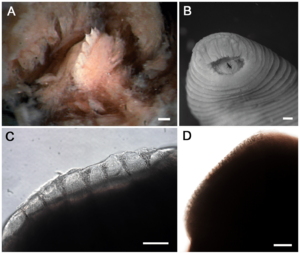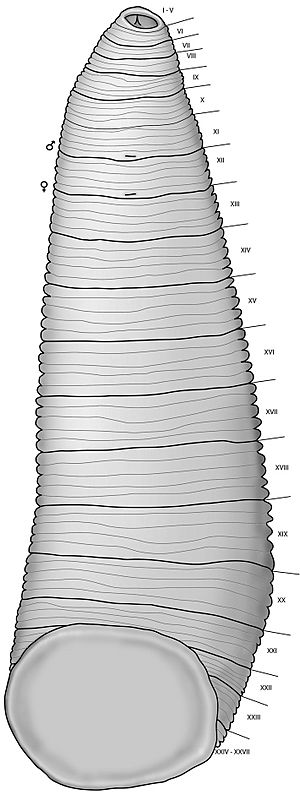Tyrannobdella facts for kids
Quick facts for kids Tyrannobdella |
|
|---|---|
 |
|
| Microscopic views: A) jaw of Tyrannobdella rex; B) anterior suction cup; C) teeth of T. rex; D) teeth of leech Limnatis paluda | |
| Scientific classification | |
| Genus: |
Tyrannobdella
|
| Species: |
rex
|
The Tyrannobdella rex is a special type of leech found in the Amazon River area of South America. It's a very unique kind of leech, being the only species in its group, called a monotypic genus. This leech gets its food by attaching to the inside of noses, mouths, and throats of mammals, including people.
Scientists discovered Tyrannobdella rex when it was found attached to a girl who had been swimming in the upper Amazon in Peru. This leech has eight teeth, which are quite big for a leech!
Genetic studies show that Tyrannobdella rex is related to another similar leech called Dinobdella ferox, which lives in Taiwan.
Contents
What Makes Tyrannobdella rex Special?
Unlike most other leeches, Tyrannobdella rex has only one jaw. On this single jaw, it has a row of eight teeth. These teeth are surprisingly large, growing up to 0.13 millimeters long. Their size is what made the scientists name the leech after the famous dinosaur, Tyrannosaurus rex!
These teeth are about five times longer than the teeth of a related leech called Limnatis. When you look at T. rex under a microscope, you usually only see six of its teeth. The other two are hidden under its skin. Another related leech, Pintobdella chiapasensis, also has fewer teeth, with six teeth on each of its three jaws.
Life and How It Eats
When T. rex is young, it bites into the soft, moist linings (called mucous membranes) inside its host's body. It then feeds on their blood. What's interesting is that T. rex doesn't just fall off after it's full, like some other leeches. It can stay attached to its host for days or even weeks! As it feeds and grows, it can reach a length of up to 7 centimeters (about 2.7 inches).
Tyrannobdella rex prefers to attach to the mucous membranes in the mouth, nose, and throat of humans. Other leeches that also live in these moist areas have been found in noses, near the eyes, and even in the urinary and reproductive systems of mammals.
What Happens if You Get a T. rex Leech?
If a Tyrannobdella rex leech gets into someone's nasal cavity (inside the nose), it can cause strong headaches. Because these leeches are small, they are often not noticed right away.
Where Does T. rex Fit in the Leech Family?
The unique single jaw of Tyrannobdella rex led scientists to create a brand new group, or genus, just for it. So far, T. rex is the only species known in this group.
Studying Tyrannobdella rex and comparing its DNA to other leeches that live inside mammals has helped scientists learn more about how leeches are related. T. rex belongs to a family called Praobdellidae. Most leeches in this family are found in Africa and Asia. Tyrannobdella rex is special because it's the only one from South America. Its closest known relative, Pintobdella chiapasensis, lives in Mexico and feeds on tapirs.
See also
In Spanish: Tyrannobdella rex para niños


